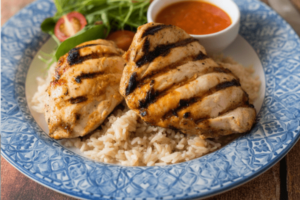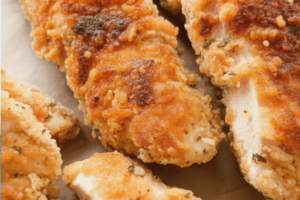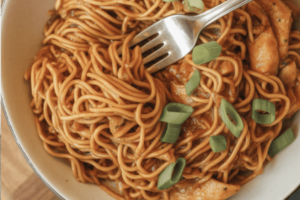If you’re like me and love a big bowl of saucy noodles, but you’re watching the carbs, this keto chow mein is about to become your new weeknight favorite. It’s savory, a little sweet, full of umami, and the best part? It’s fast enough to make after work.
Years ago, I was basically keeping our local takeout spot in business. Three practices a week in high school meant three giant containers of chicken chow mein. These days, I try to keep things a little healthier (and cheaper) at home. This version hits all the right notes without the sugar and carbs that usually come with takeout.
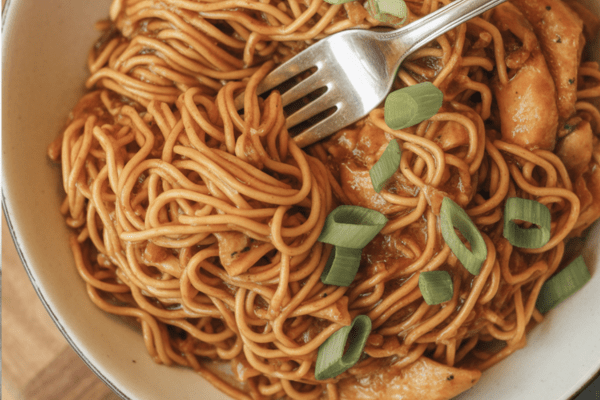
The trick? Shirataki noodles that soak up all the sauce. It’s so satisfying, but light enough that I don’t feel weighed down. I’ve even convinced my family to love it—and they’re not exactly keto eaters.
What You’ll Need for This Recipe
If you’ve stocked your pantry for any kind of keto-friendly stir-fry, you’re halfway there already. Here’s what I use, plus a few notes from my own kitchen.
Soy Sauce or Coconut Aminos
I use coconut aminos when cooking for friends who avoid gluten or soy. It’s a bit sweeter and milder than soy sauce, but both work beautifully.
Fish Sauce
This is my secret weapon. It might smell strong in the bottle, but a splash in the pan adds an unmistakable depth that makes homemade stir-fries taste restaurant-quality.
Rice Vinegar
Brightens everything up and balances the richness of the sauce.
Golden Swerve or Lakanto
These are my usual keto sweeteners since you can swap them 1:1 with sugar. If you use another brand like allulose or erythritol, just remember they’re often less sweet, so you may want to taste and adjust.
Xanthan Gum
Just a pinch thickens the sauce like cornstarch would, but without the carbs. I resisted buying this for ages, but now I always keep a bag around.
Sesame Oil
Nutty, toasty flavor. A drizzle at the end makes it taste authentic.
Chicken Thighs
I love using thighs because they stay juicy and flavorful. I’ve made this with breast too—it works fine, but watch the cooking time so it doesn’t dry out.
Shirataki Noodles
They’re nearly carb-free, and once stir-fried they lose that odd slippery texture. I rinse and drain them well before adding them to the pan. If you haven’t tried them yet, they’re worth getting used to!
Mild Oil
Avocado oil is my go-to for high heat cooking. Vegetable oil works in a pinch.
Cabbage and Carrot
These give crunch and color. I often buy pre-shredded to save time.
Bean Sprouts
Fresh is great, but I’ve used canned plenty of times. Just drain and rinse them well.
Green Onions
For freshness and a little bite. I use both the white and green parts.
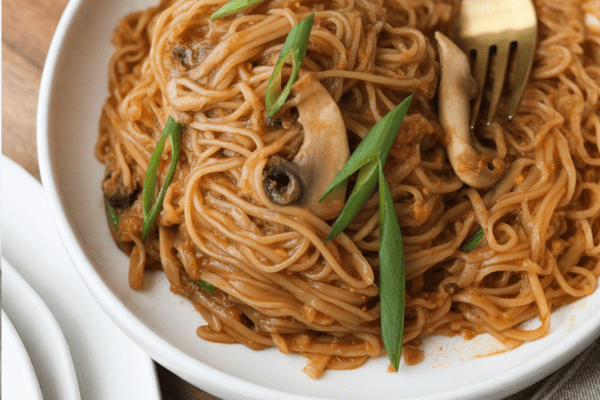
How I Make It at Home
This is one of those weeknight recipes where I don’t even think too hard anymore—I’ve made it so many times. Here’s how I usually do it:
Prep Everything First
Stir-fries go quickly, so I chop all my veggies and mix the sauce before anything hits the pan. It keeps me from frantically slicing while things burn.
Make the Sauce
I whisk together soy sauce (or aminos), fish sauce, rice vinegar, sweetener, a little xanthan gum, and sesame oil. It thickens up beautifully in the pan.
Cook the Chicken
I sear the chicken thighs until they’re nicely browned and cooked through. Don’t rush this step—that browning is pure flavor.
Add Veggies
In go the cabbage, carrot, and bean sprouts. They need just a few minutes to soften while staying crisp.
Add the Noodles and Sauce
The drained shirataki noodles go in last with the sauce. I toss everything over high heat so the noodles soak up all those savory flavors.
Finish with Green Onions
I like to stir them in at the end for a burst of freshness.
Personal Tips and Tricks
Dry Those Noodles Well
Shirataki noodles come packed in liquid, and that can make your stir-fry watery if you don’t drain them well. I rinse them, then pat them dry with paper towels.
Taste and Adjust
Every brand of sweetener is a bit different. I always taste the sauce before adding it to the pan and adjust the sweetness or saltiness to my liking.
High Heat is Key
I use my biggest, hottest pan so everything cooks quickly and the veggies stay crisp.
Don’t Skip the Sesame Oil
It’s not just garnish. That little drizzle at the end ties everything together.

Serving Ideas from My Kitchen
This keto chow mein is hearty enough to stand alone, but sometimes I serve it family-style with a few other dishes. Here’s what we love:
- Cauliflower fried rice for extra veggies.
- Keto beef and broccoli for the meat-lovers.
- Keto orange chicken for a sweet-savory option.
It’s the kind of spread that feels like a takeout feast, but you know exactly what’s in it.
Easy Variations We Love
Change Up the Noodles
If I don’t have shirataki, I’ll use extra cabbage for a cabbage-noodle vibe. I’ve also tried edamame noodles, zucchini spirals, even spaghetti squash.
Swap the Protein
I’ve made this with thinly sliced pork or shrimp. Both work beautifully and cook quickly.
Go Meatless
Skip the meat entirely and double up on veggies. Bell peppers, celery, mushrooms, and extra sprouts make it filling.
Add Fresh Flavors
Fresh ginger or minced garlic add another layer of flavor if I have them on hand.
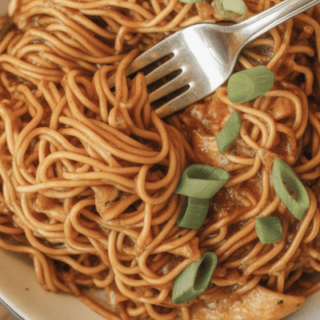
Keto Chicken Chow Mein
This low carb chow mein is a weeknight wonder—tender chicken, crisp veggies, and a flavorful sauce over shirataki noodles that satisfy the craving without the carbs. It’s quick, easy, and tastes just like your favorite takeout—without the guilt.
Ingredients
- For the Sauce:
- 2 tablespoons rice vinegar
- 3 tablespoons soy sauce (or coconut aminos for gluten-free)
- 1 teaspoon fish sauce
- 2 tablespoons Brown Swerve or Lakanto
- 1/4 cup water
- 1/4 teaspoon xanthan gum
For the Chicken:
- 1 pound boneless, skinless chicken thighs, cut into 1-inch cubes
- 1 tablespoon sesame oil
- 2 teaspoons soy sauce
- 1 teaspoon rice vinegar
For the Stir Fry:
- 8 ounces shirataki noodles (spaghetti shape)
- 4 cups shredded cabbage
- 1 cup shredded carrots
- 1 cup bean sprouts
- 1 bunch green onions, thinly sliced (white and green parts)
- 4 teaspoons avocado or vegetable oil
Instructions
- Make the Sauce: In a small bowl, combine soy sauce, fish sauce, rice vinegar, sweetener, water, and xanthan gum. Whisk until smooth and set aside.
- Marinate and Cook the Chicken: In a large bowl, toss the chicken pieces with sesame oil, soy sauce, and rice vinegar. Warm a large skillet over medium-high heat. Add the chicken in a single layer (work in batches if needed to avoid crowding). Sear for about 2–3 minutes per side until golden. Transfer the cooked chicken to a plate and set aside.
- Prepare the Noodles: Rinse shirataki noodles thoroughly in a colander. Let them drain well. Heat 2 teaspoons of oil in the same skillet over medium heat. Add the noodles and “dry fry” them for about 5 minutes, stirring often, until most of the moisture cooks off. Remove them to a bowl.
- Cook the Vegetables: Add the remaining 2 teaspoons of oil to the skillet. Stir in shredded cabbage, carrots, and bean sprouts. Sauté for a few minutes until they start to soften but still have some crunch.
- Combine and Finish: Return the cooked chicken and noodles to the pan. Pour in the sauce. Stir well to coat everything evenly and bring to a gentle boil. Cook for a few more minutes until the chicken is heated through and the sauce slightly thickens.
- Serve: Remove from heat and fold in the sliced green onions. Taste and adjust seasoning if desired. Serve hot and enjoy!
Nutrition Information:
Yield: 4 Serving Size: 1Amount Per Serving: Calories: 327Total Fat: 16gSaturated Fat: 4gTrans Fat: 0gUnsaturated Fat: 12gCholesterol: 138mgSodium: 1161mgCarbohydrates: 16gFiber: 5gSugar: 7gProtein: 32g
Chickenrecipes.blog, occasionally offers nutritional information for recipes contained on this site. This information is provided as a courtesy and is an estimate only. This information comes from online calculators. Although allchickenrecipes.com attempts to provide accurate nutritional information, these figures are only estimates.
How I Store Leftovers
If there’s any left (rare in our house), I keep it in an airtight container in the fridge. It reheats well in a hot pan or even in the microwave. The flavors often meld and deepen overnight, making it even better the next day.
This keto chow mein has become one of my easiest weeknight wins. It satisfies the takeout cravings without the heavy carb crash, and everyone at the table is happy—even the non-keto eaters.
If you’ve been looking for a low-carb noodle dish that actually tastes good, give this a try. It’s a keeper in our kitchen, and I think you’ll love it too.
Try other Keto recipes:
